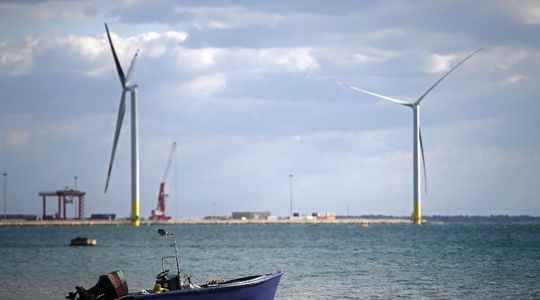The war in Ukraine has strengthened the will of Europe and France to free itself from its dependence on Russian gas. To achieve this, Brussels relies on renewable energies, and in particular wind power. “The more we are interdependent between European countries, the less we will be dependent on Russia”, argued the President of the European Commission, Ursula von der Leyen, at the end of May. A few days later, on June 3, the EU also announced that it wanted to “multiply by four” its “total capacity in offshore wind power by 2030 and by ten by 2050”. Can Europe’s energy salvation in the face of Russian blackmail really come from wind power? Is this solution profitable and viable?
A first indicator pleads in favor of the “yes”: the price. Long considered less cheap than nuclear or fossil fuels, wind power is surfing, like solar power, on a sharp drop in the price of renewables in recent years. “It is one of the cheapest energies,” argues the France director of Iberdrola Renewables Emmanuel Rollin. An asset that allows wind power to develop rapidly: by 2050, it should ensure the production of 50% of European electricity (according to Wind Europe), compared to 16% today. “Provided of course to electrify all areas of the economy that can be,” says Emmanuel Rollin. Still 50% of EU energy consumption comes from fossil fuels today. A study by Ademe published at the end of May also highlights the “major interest” of the development of renewables to reduce imports of fossil fuels, particularly from Russia.
Wind power is also viewed favorably by many European countries, where the nuclear industry is fiercely decried. Especially since the latter has shown that it cannot produce without limit. “When EDF says it’s 14 EPRs maximum by 2050, it’s proof that we must be able to rely on other sources, renewable, to produce carbon-free energy”, argues Nicolas Goldberg, energy expert at Colombus Consulting.
Competitiveness challenge
However, several challenges complicate the situation. First of all, despite its competitive prices, wind power is also suffering from the inflationary wave. Thus the price of photovoltaic modules, divided by four in five years, has increased by 16% last year according to the International Energy Agency. The cost of wind power took 9%: offshore in particular suffers from the additional cost of rare metals and copper, which also affects wiring and connections. In France, the industry is sounding the alarm. Projects are stopped because of the additional costs in solar, wind, small hydroelectricity and even biogas. In question, contracts signed before the boom in costs, contractualizing a price of electricity at levels no longer covering the costs. And there is no question of catching up on the rise in market prices, since the operator must return to the State the difference with that recorded in his contract. “The turbine manufacturers are suffering because there is not yet a redistribution of value between sellers and producers of wind electricity”, details the France CEO of Siemens Gamesa Renewable Energies, Filippo Cimitan.
Then, the ability of wind turbine manufacturers to face Chinese competition raises questions. Although many European players are recognized in the field, they have not forgotten the fate reserved for their solar panel manufacturer counterparts, whose industry was nipped in the bud in the early 2000s, having been unable to in the face of Chinese competitiveness. “If the price remains the only selection criterion during calls for tenders, we risk missing out on the opportunity to support local industry, and therefore mechanically local jobs”, notes Nicolas Goldberg on this subject. Without more protectionism from the EU, the risk of seeing the European turbine manufacturers in turn ousted is therefore real, and would place the 27 in a new form of dependence, this time on China.
Gain acceptability
A final source of concern: social acceptability. Because even if the European turbine manufacturers manage to overcome the challenges of profitability, part of the public opinion remains to be convinced so that the wind projects can see the light of day on time. An issue that also concerns wind power at sea, the beginnings of which are not without clashes, as we can see with the offshore park of Saint-Brieuc, which arouses the anger of fishermen. For Filippo Cimitan (Siemens Gamesa), this battle involves changing scale: “Today we must adhere to a national energy plan, rather than to separate projects, so as to be able to maintain the speed of construction necessary to achieve energy independence,” he says.
To gain in efficiency, a simplification of procedures is also necessary, otherwise the deployment of wind power could find it difficult to meet the commitments set at European level. “The limit is time and bureaucracy”, underlines the energy expert Nicolas Goldberg, specifying in passing that “the deployment of a wind farm takes on average seven years in France”. Same observation for Emmanuel Rollin (Iberdrola Renewables), who considers this administrative flexibility essential to allow manufacturers “to gain speed, increase production volumes, and thus create economies of scale”.
Ultimately, offshore wind power, whose production Brussels aims to multiply by 25 by 2050, could also bring a new and very useful use to Europe: by implementing electrolyzers on certain wind turbines at sea, turbine operators could generate low-carbon hydrogen in addition to electricity. The projects are still at the pilot stage, but the opportunities in mobility or the decarbonization of industry could appeal to certain manufacturers. It therefore remains to be seen whether the objectives that the various member countries have set themselves to deploy it will be achieved. For France, the bet set is ambitious and would amount to installing the equivalent of the installed power of an EPR every year. But experts assure that “the course is good”.
